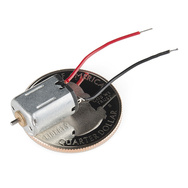Looking Outwards: Sensors and Actuators
Discovery 1: IR Distance Sensor
This SHARP distance sensor bounces [infrared light] off objects to determine how far away they are. It returns an analog voltage that can be used to determine how close the nearest object is.
This IR sensor seems like it has interesting possibilities because it would let you have virtual creations respond to the proximity of their viewers. Since personal space is a pretty meaningful social cue, allowing virtual creations to respond to it seems like it would have evocative potential. Some ideas off the top of my head for how to use this would be:
- A virtual creature which shys away depending on how the viewer approaches it (this would be similar to my creature/ecosystem design but use actual proximity of a viewer rather than mouse proximity)
- A virtual siren who would sing and beckon viewers closer.
- A mobile robot-creature that would change its behavior depending on how near it was to a person. (e.g., interacting with that person when they are within a foot or less of him or her.)
Discovery 2: Coin Acceptor
When a valid coin is inserted, the output line will pulse for 20-60ms (configurable)
This coin acceptor seems interesting because using it in a project would let you play with the dynamics of payment, and what people are willing to pay for, etc. Some quick ideas for possible uses are:
- Submitting 25 cents to get access for a few seconds to a webcam somewhere interesting. One example would be having a “viewfinder” (like the kind they have on top of the Empire State Building or the Space Needle) that is somewhere else, but that would show you a view from somewhere else in the world.
- A social commentary piece where you put in coins and then they “trickle down” through a bunch of obstacles and end up being distributed unevenly at the bottom. (mockery of trickle-down economics) Alternatively, you could let people interact with it and control where things trickle down with a knob or knobs representing economic variables.
Discovery 3: Toy Motor
Gear motors allow the use of economical low-horsepower motors to provide great motive force at low speed such as in lifts, winches, medical tables, jacks and robotics. They can be large enough to lift a building or small enough to drive a tiny clock. (src)
This toy motor seems interesting 1. because it is cheap, so using many of them together would not be expensive to do, and 2. because its small size opens up interesting possibilities for hiding the motor itself. Some ideas for this motor are:
- Making everyday objects move. Maybe recreating the “Be Our Guest” scene from Beauty and the Beast with standard dishware (this might not be feasible, and definitely echoes Adam’s Pixar lamp project)
- Doing animatronics with small dolls or stuffed animals. Maybe you could have a version of the Sims in which people control actual dolls.


